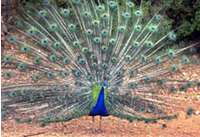Welcome to the Page on National Info of India. This Page gives information about India's
national symbols which makes all of us proud. Click on the respective links to directly go
to the respective areas.
National Flag
National Anthem
National Song
National Symbol
National Bird
National Animal
National Flower
National Fruit
National Tree
National Flag

The national flag is a horizontal tricolour of deep saffron (kesari) at the top, white in the middle and dark green at the bottom in equal proportion. The ratio of width of the flag to its length is two to three. In the centre of the white band is a navy blue charkha or the wheel which appears on the abacus of the Sarnath Lion Capital of Ashoka. Its diameter approximates to the width of the white band and it has 24 spokes. The design of the national flag was adopted by the Constituent Assembly of India on July22, 1947.
Back To Top
National Anthem
The song, Jana-gana-mana, composed originally in Bengali by Rabindranath Tagore. Its Hindi version by the Constituent Assembly as the National Anthem of India on January 24, 1950.
Jana-gana-mana-adhinayaka, jaya he,
Bharata-bhagya-vidhata.
Punjab-Sindh-Gujarat-Maratha,
Dravida-Utkala-Banga,
Vindhya-Himachala-Yamuna-Ganga Uchchala-Jaladhi-taranga.
Tava shubha name jage, Tava shubha asisa mage,
Gahe tava jaya gatha,
Jana-gana-mangala-dayaka jaya he Bharata-bhagya-vidhata.
Jaya he, jaya he, jaya he, Jaya jaya jaya, jaya he!
Back To Top
National Song
The song, Vande Mataram, composed in Sanskrit by Bankimchandra Chatterji, was a source of inspiration to the people in their struggle for freedom. It has an equal status with Jana-gana-mana.
Vande Mataram!
Sujalam, suphalam, malayaja shitalam,
Shasyashyamalam, Mataram!
Shubhrajyothsna pulakitayaminim,
Phullakusumita drumadala shobhinim,
Suhasinim sumadhura bhashinim,
Sukhadam varadam, Mataram!
Vande Mataram!
Back To Top
National Symbol

The National Symbol is an adaptation from the Sarnath Lion Capital of Emperor Ashoka, who ruled from 272 BC to 232 BC. In the original pillar, there are four lions, standing back to back, mounted on an abacus with a frieze carrying sculptures in high relief of an elephant, a galloping horse, a bull and a lion separated by intervening wheels over a bell-shaped lotus. Carved out of a single block of polished sandstone, the Capital is crowned by the Wheel of Law (Dharma Chakra).In the State Emblem adopted by the Government of India on January 26 1950, only three lions are visible, while the fourth is hidden from view. The wheel appears in relief in the centre of the abacus with a bull on right and a horse on left, and the outlines of the other wheels on the extreme right and left.
Back To Top
National Bird

The Indian peacock, Pavo cristatus (Linnaeus), the national bird of India, is a colourful, swan-sized bird, with a fan-shaped crest of feathers, a white patch under the eye and a long, slender neck.
The male of the species is more colourful than the female, with a glistening blue breast and neck, and a spectacular bronze-green train of around 200 elongated feathers. The female is brownish, slightly smaller than the male, and lacks the train. The elaborate courtship dance of the male, fanning out the tail and preening its feathers is a gorgeous sight.
The peacock is widely found in the Indian sub-continent from the south and east of the Indus river, Jammu and Kashmir, east Assam, south Mizoram and the whole of the Indian peninsula. The peacock enjoys immense protection. It is fully protected under the Indian Wildlife (Protection) Act, 1972.
Back To Top
National Animal

The magnificent tiger, Panthera tigris (Linnaeus), is a striped animal. It has a thick yellow coat of fur with dark stripes. The combination of grace, strength, agility and enormous power has earned the tiger its pride of place as the national animal of India. It jumps very high and its are mostly look in jungle. It occurs in various stripes colors like white, red, black.
Back To Top
National Flower

The Lotus or waterlily is an aquatic plant of Nymphaea with broad floating leaves and bright fragrant flowers that grow only in shallow waters. The leaves and flowers float and have long stems that contain air spaces. The big attractive flowers have many petals overlapping in a symmetrical pattern. The root functions are carried out by rhizomes that fan out horizontally through the mud below the water. Lotuses, prized for their serene beauty, are delightful to behold as their blossoms open on the surface of a pond. In India the sacred lotus is legendary and much folklore and religious mythology is woven around it.
Back To Top
National Fruit

A fleshy fruit, eaten ripe or used green for pickles etc., of the tree Mangifera indica, the mango is one of the most important and widely cultivated fruits of the tropical world. Its juicy fruit is a rich source of Vitamins A, C and D. In India there are over100 varieties of mangoes, in different sizes, shapes and colours. Mangoes, have been cultivated in India from time immemorial. The poet Kalidasa sang its praises. Alexander savoured its taste, as did the Chinese pilgrim Hieun Tsang. Akbar planted 100,000 mango trees in Darbhanga, known as Lakhi Bagh.
Back To Top
National Tree
Indian fig tree, Ficus bengalensis, whose branches root themselves like new trees over a large area. The roots then give rise to more trunks and branches. Because of this characteristic and its longevity, this tree is considered immortal and is an integral part of the myths and legends of India. Even today, the banyan tree is the focal point of village life and the village council meets under the shade of this tree.
Back To Top






The midi titled "Tabi no Totyu de" playing is performed by Yuko Ohigashi and used with permission. Click below to visit her website.

|
|

